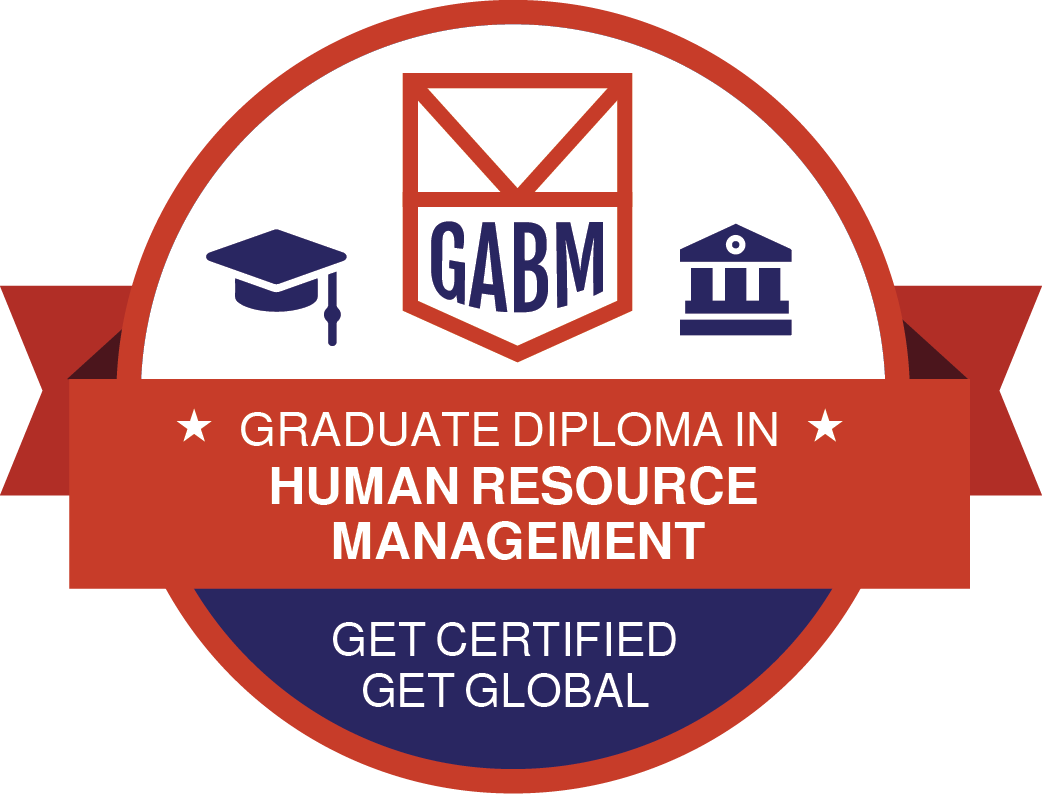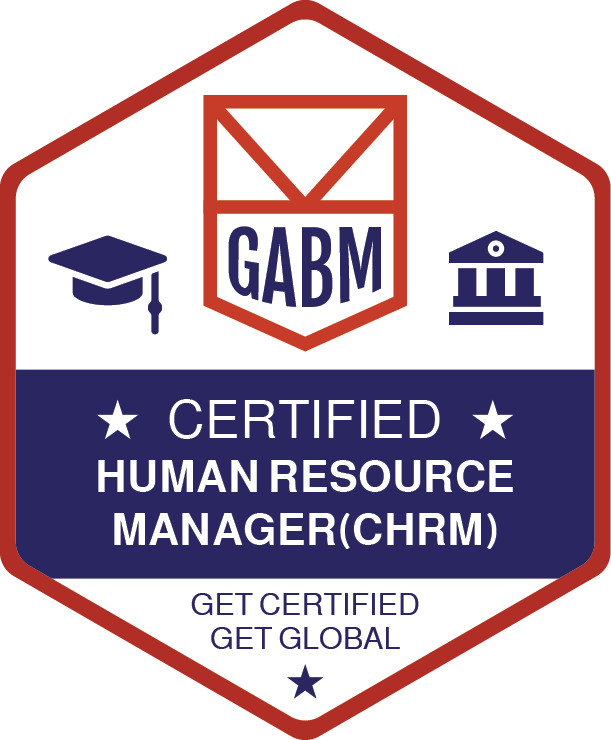Overview
The GABM Global academy of business and management offers you the opportunity to enhance your professional skills and knowledge of human resource management and development. We seek to enable you to gain a competitive edge in pursuing your professional career and to make an outstanding contribution to the performance of your employing organization.
This program provides an introduction to the various functions of human resource management, including compensation and benefits, staffing, recruitment and selection, research, labor relations, training and development, health and safety, planning, mediation and arbitration, the influence of government legislation on industry, and human rights legislation and employment equity.

Program Aims
This program provides an introduction to the various functions of human resource management, including compensation and benefits, staffing, recruitment and selection, research, labor relations, training and development, health and safety, planning, mediation and arbitration, the influence of government legislation on industry, and human rights legislation and employment equity.
The individual modules have their own aims and objectives. Collectively they provide the overall aims and objectives of the programme, which are,
- To provide you with a high quality graduate management qualification and education and development experience of intrinsic worth that will enable you to achieve learning outcomes at a level appropriate for the award of qualifications of the academy.
- To provide an intellectually stimulating programme of professional graduate management
education for students desiring to develop their career in the human resource management
and development profession. - To develop the operational skills and behaviors of human resource management and development practitioners through a curriculum that combines rigorous academic study, skills development and application.
- Critically evaluate the principles and practices of specific human resource management and development topics from an academic and organizational perspective.
- Demonstrate an ability to develop ideas and arguments, to identify appropriate professional responses to organizational problems and issues and to apply these at a level appropriate to the management professional areas and behavior.
- Apply your professional skills and knowledge within a work environment.
- Successfully demonstrate your continuous professional development.
The Programme objectives are,
Graduate Qualifications
- Graduate Certificate in Human Resource Management
- Graduate Diploma in Human Resource Management
Designation Qualifications
- Certified Human Resource Professional (CHRP)
- Certified Human Resource Manager (CHRM)
- Certified Human Resource Director (CHRD)





Awards are conferred in accordance with the GABM General and Academic Regulations for Students and the GABM Postgraduate Programme Assessment, Progression and Award Regulations.
Graduate Certificate in
Human Resource Management
Indian Rupees
Indian Nationals
12,999/-
US Dollars
International
Students
200$
Complete Learning Pack
4-6 Months Access
Graduate Diploma in
Human Resource Management
Indian Rupees
Indian Nationals
14,999/-
US Dollars
International
Students
250$
Complete Learning Pack
4-6 Months Access
Certified Professional in
Human Resource Management
Indian Rupees
Indian Nationals
14,999/-
US Dollars
International
Students
250$
Complete Learning Pack
4-6 Months Access
Certified Manager in
Human Resource Management
Indian Rupees
Indian Nationals
18,999/-
US Dollars
International
Students
300$
Complete Learning Pack
4-6 Months Access
Certified Director in
Human Resource Management
Indian Rupees
Indian Nationals
24,999/-
US Dollars
International
Students
350$
Complete Learning Pack
4-6 Months Access
Entry Requirements
Entrants to this programme are normally required to have attained the following.
- Applicants should either have at least Secondary school or entry to bachelor degree for
Graduate certificate - Students who have completed bachelor degree / fresher or final year students can apply for
Graduate diploma. - Students who have completed bachelor degree / fresher or final year students can apply for
professional certificate. - Bachelor degree with 2 years’ experience for Managerial certificate.
- Bachelor degree with 2 years’ experience for Managerial certificate.
- Bachelor degree with 5 years’ experience for Director Certificate.
- A good honors degree or equivalent in a relevant subject or and work experience in relevant
management or other related field.
Career Prospect
This well-respected program will enhance your HR career prospects. As a graduate, you’ll benefit from GABM
Global academy of business and management excellent reputation in the business community when you are ready to look for employment.Our Human Resource management programme will equip with important management expertise and core HR knowledge in order to prepare you for such role as ,
- Career Advisor
- Equality and Diversity officer
- HR advisor
- HR analyst
- HR compliance administrator
- HR employee benefits manager
- HR generalist
- HR manager
- HR rewards manager
- Recruitment manager
- Reward analyst
- Training advisor
Who Should Attend
Learning and Training Methods
The Human Resource management programme uses a number of different assessment techniques that will allow you to demonstrate your understanding of concepts and issues covered. These may be broadly categorized as ‘coursework’ which may be in the form of individual or group assignments, practical problem-solving exercises and presentations.
It should be emphasized that the purpose of assessment is not only grade you, and provide information to facilitate management of the course, but also to provide feedback to you. In this manage it accordingly. You should keep all the returned assessment work in a file as you may have to submit this at the end of the programme for the academy to assess.
Individual model leaders will distribute information on the methods of assessment used, and their weighing at the start of each module.
Program Curriculum
|
Module / Description |
Graduate Certificate |
Graduate Diploma |
Certified Financial Professional |
Certified Financial Manager |
Certified Financial Director |
|---|---|---|---|---|---|
| Human resource management: An overview. | |||||
| Business Ethics and Corporate social responsibility | |||||
| Equal employment opportunity affirmative action and work force diversity | |||||
| Strategic planning, human resource planning and Job analysis | |||||
| Recruitment | |||||
| Selection | |||||
| Performance management and appraisal | |||||
| Training and Development | |||||
| Direct financial compensation | Indirect financial compensation | Labor unions and collective bargaining | Internal employee relations | Employee safety, health and wellness | Global Human resource management | Assignments | Project Report – 100 Points |
| Credit Points |
200 |
260 |
360 |
380 |
380 |
Modules
- Define human resource management
- Human resource management functions
- Who performs human resource management activities
- Human resources as a strategic business partner
- Dynamic human resource management environment
- Corporate culture and human resource management
- Employer branding
- Human resource management in small business
- Country culture and global business
- Human resource management profession
- Defining ethics, corporate social responsibility and corporate sustainability
- Business ethics
- Sources of ethical guidance
- Legislating ethics
- Creating a ethical culture and a code of ethics
- Human resource ethics
- Linking pay to ethical behavior
- Ethics training
- Corporate social responsibility
- Corporate social responsibility
- Conducting a social audit
- Can corporate social responsibility succeed in global environment
- Introduction
- Equal employment opportunity : overview
- Equal employment opportunity : overview
- Who’s responsible for ensuring equal employment opportunity
- Defining and operationalizing illegal discrimination
- Affirmative action
- Uniform guidelines on preventing specific illegal employment discrimination
- Global sexual harassment
- Diversity
- Diversity management
- Elements of diverse workforce
- Strategic planning process
- Mission determination
- Human resource planning
- Forecasting human resource requirements
- Forecasting human resource availability
- Shortage or surplus of workers forecasted
- Succession planning. A component of strategic planning
- Job analysis. A basic human resource management tool
- Types of job analysis information
- Job analysis methods
- Job description
- Standard occupational classification ( SOC ) and the occupational information
network - Job analysis for team members
- Job analysis and the law
- Competencies and competency theory
- Global talent management
- Recruitment defined
- External recruitment sources
- Recruiting technology
- Traditional external recruitment methods
- Overcoming barriers to the use of marketing research
- Tailoring recruitment methods to sources
- Environment of recruitment
- Alternatives to recruitment
- Global implications for recruitment
- Significance of employee selection
- Selection process
- Preliminary screening
- Review of application and review of resumes
- Selection tests
- Employment interview
- Pre-employment screening and background checks
- Selection decision
- Metrics for evaluating the effectiveness and recruitment / selection
- Environmental factors affecting the selection process
- Selection in a global environment
- Performance management
- Performance appraisal
- Uses of performance appraisal
- Performance appraisal process
- Establish performance criteria ( standards )
- Responsibility for performance appraisal
- Performance appraisal period
- Choosing a performance method
- Problems in performance appraisal
- Characteristics of an effective appraisal systems
- Legal considerations in performance appraisal
- Performance appraisal interview
- National culture and performance appraisal
- Training and development process
- Determine specific training and development needs
- Training methods
- Training and development delivery systems
- Implementing training and development programs
- Metrics for evaluating training and development
- Factors influencing training and development
- Human resource management training initiatives
- Career and career paths
- Career planning approaches
- Career development and career development methods
- Management development
- Organizational development : a strategic human resource tool
- Learning organization as a strategic mindset
- Training in the global context
- Compensation : an overview
- Components of direct financial compensation
- Determinants of direct financial compensation
- Contextual influences on direct financial compensation
- Build job structures using job evaluation
- Competitive compensations policies
- Market competitive pay structures : job pricing using compensation surveys
- Sales representative compensation
- Contingent worker compensation
- Executive compensation
- Indirect financial compensation
- Legally required benefits
- Discretionary benefits
- Health care
- Retirement plans
- Life insurance and disability insurance
- Paid time off
- Employee services
- Voluntary benefits
- Employee benefits legalization
- Customized benefits plans
- Global customized benefits
- Communicating information about the benefits package
- Workplace flexibility (work life balance)
- Why do union exists
- Why employee join unions
- Prevalence of unions
- Organized labor’s strategies for a stronger movement
- Laws affecting collecting bargaining
- Steps that lead to forming a bargaining unit
- Collective bargaining process
- Bargaining issues
- Preparation for negotiations
- Negotiating the agreement
- Breakdowns in negotiations
- Reaching the labor – management agreement
- Ratifying the labor management agreement
- Administration of the labor management agreement
- Grievance procedure in a union environment
- Union decertification
- Collective bargaining in the public sector
- Labor unrest in china
- Employment at will
- Discipline and disciplinary action
- Disciplinary action process
- Approaches to disciplinary action
- Problems in the administration of disciplinary action
- Termination
- Termination of employees at various levels
- Demotion of employees at various levels
- Downsizing
- Ombudsperson
- Alternative dispute resolution
- Transfers
- Promotions
- Resignation
- Retirements
- Administering disciplinary action in other countries
- Nature of role of safety, health and wellness
- Occupational safety and health administration
- OSHA and whistle blowers
- OSHA and small business
- Safety: the economic impact
- Focus on safety program
- Musculoskeletal disorders .
- Ergonomics
- Workplace bullying and violence
- Employee wellness
- Social networking and wellness
- Nature of stress
- Burnout
- Physical fitness program
- Substance abuse
- Substance abuse – free workplace
- Implementing a drug testing program
- Employee assistance program
- Health care in global environment
- Evolution of global business
- Global strategic human resource management
- Setting the stage for global HR practice
- Global staffing
- Global performance management and human resource development
- Global compensation
- Global safety and health
- Global employee and global relations
- Globalization to small to medium sized business
Program Structure
| Module Code | Module | Core/Elective | Credit Points |
|---|---|---|---|
| HRM-101 | Human resource management: An overview. | Core | 20 |
| HRM-102 | Business Ethics and Corporate social responsibility | Core | 20 |
| HRM-103 | Equal employment opportunity affirmative action and work force diversity | Core | 20 |
| HRM-104 | Strategic planning, human resource planning and Job analysis | Elective | 20 |
| HRM-105 | Recruitment | Core | 20 |
| HRM-106 | Selection | Core | 20 |
| HRM-107 | Performance management and appraisal | Elective | 20 |
| HRM-108 | Training and Development | Core | 20 |
| HRM-109 | Direct financial compensation | Elective | 20 |
| HRM-110 | Indirect financial compensation | Elective | 20 |
| HRM-111 | Labor unions and collective bargaining | Core | 20 |
| HRM-112 | Internal employee relations | Core | 20 |
| HRM-113 | Employee safety, health and wellness | Core | 20 |
| HRM-114 | Global Human resource management | Core | 20 |
| Distinctive features of the Programme | |||
|
|||
Assessment Pattern
The GABM global academy consists of variety of assessment modes.
- Assessed assignments ( in essay , report, problem, case studies or short question format)
- Written examination papers.
- Project report submission.
The exact combination of assessment varies from programme to programme and from module to module.
| Programme | Assessment pattern | Credit Points |
|---|---|---|
| Graduate certificate in Human Resourcem Management |
1 Assignment | 200 |
| Graduate Diploma in Human Resource Management |
2 Assignment | 260 |
| Certified Human Resource Professional(CHRP) |
3 Assignment | 360 |
| Certified Human Resource Manager(CHRM) |
3 Assignments with project report | 380 |
| Certified Human Resource Director(CHRD) |
3 Assignments with project report | 380 |
Note: Assignments and patterns are subject to change without notice; candidates are required to contact office of executive education and professional certification of the academy for respective programme before start of the course.

